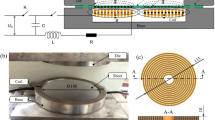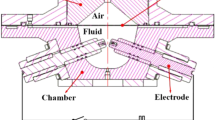Abstract
Electromagnetic forming (EMF) processes require no more than about 300 μs to complete. Given the high speeds involved (150 m/s to 250 m/s), it is almost impossible to determine the flow stress through the application of a mechanical property test. In this study, the flow stress of Al 1100-O at high speeds was predicted by inverse parameter estimation. The constitutive equation of flow stress is given by the Cowper–Symonds model. Firstly, a practical experiment process is set up with a spiral coil for the EMF-free bulge test. To compare the results of our experiments with the numerical results, an EMF simulation was prepared and the X- and Zdisplacements of the sheet on the center line were measured to compare them with the results of experiments as obtained using 2- D scanning. To find the optimal properties for the EMF process, a reduced-order model (ROM) with the Kirging method was adopted to form the basis. From this model, an inverse parameter estimation was conducted using the nonlinear least squares method with a genetic algorithm. By comparing the results of the experiments with the ROM results, the validity of the flow stress obtained by an inverse estimation was validated.
Similar content being viewed by others
References
Psyk, V., Risch, D., Kinsey, B., Tekkaya, A., and Kleiner, M., “Electromagnetic Forming-A Review,” Journal of Materials Processing Technology, Vol. 211, No. 5, pp. 787–829, 2011.
Imbert, J., Worswick, M., Winkler, S., Golovashchenko, S., and Dmitriev, V., “Analysis of the Increased Formability of Aluminum Alloy Sheet Formed using Electromagnetic Forming,” SAE Transactions, Vol. 114, No. 5, pp. 6–18, 2005.
Noh, H.-G., Song, W.-J., Kang, B.-S., and Kim, J., “3-D Numerical Analysis and Design of Electro-Magnetic Forming Process with Middle Block Die,” Int. J. Precis. Eng. Manuf., Vol. 15, No. 5, pp. 855–865, 2014.
Livemore Software Technology Corporation, “Electromagnetism and Linear Algebra in LS-DYNA,” ftp://ftp.lstc.com/anonymous/outgoing/inaki/docs/.../EM_theory.pdf (Accessed 17 OCT 2016)
Çaldichoury, I. and L’Eplattenier, P., “Validation Process of the Electromagnetism (EM) Solver in LS-DYNA® V980: The Team Problems,” Proc. of 12th International LS-DYNA User Conference, pp. 1–14, 2012.
Lim, J. H., “Study on Dynamic Tensile Tests of Auto-Body Steel Sheet at the Intermediate Strain Rate for Material Constitutive Equations,” Ph.D. Thesis, Department of Mechanical Engineering, KAIST, 2005.
Demir, O. K., Hö hling, O., Risch, D., Brosius, A., and Tekkaya, A., “Determination of the Material Characteristics by Means of a High Speed Tensile Test-Experiments and Simulations,” International Journal of Material Forming, Vol. 1, No. 1, pp. 1331–1334, 2008.
Gerlach, R., Kettenbeil, C., and Petrinic, N., “A New Split Hopkinson Tensile Bar Design,” International Journal of Impact Engineering, Vol. 50, pp. 63–67, 2012.
Hernandez, C., Maranon, A., Ashcroft, I., and Casas-Rodriguez, J., “A computational Determination of the Cowper-Symonds Parameters from a Single Taylor Test,” Applied Mathematical Modelling, Vol. 37, No. 7, pp. 4698–4708, 2013.
Sasso, M., Newaz, G., and Amodio, D., “Material Characterization at High Strain Rate by Hopkinson Bar Tests and Finite Element Optimization,” Materials Science and Engineering: A, Vol. 487, No. 1, pp. 289–300, 2008.
Milani, A. S., Dabboussi, W., Nemes, J. A., and Abeyaratne, R. C., “An Improved Multi-Objective Identification of Johnson-Cook Material Parameters,” International Journal of Impact Engineering, Vol. 36, No. 2, pp. 294–302, 2009.
Lan, J., Dong, X., and Li, Z., “Inverse Finite Element Approach and Its Application in Sheet Metal Forming,” Journal of Materials Processing Technology, Vol. 170, No. 3, pp. 624–631, 2005.
Su, X. Y., Yu, T. X., and Reid, S. R., “Inertia-Sensitive Impact Energy-Absorbing Structures Part II: Effect of Strain Rate,” International Journal of Impact Engineering, Vol. 16, No. 4, pp. 673–689, 1995.
Olsson, A., Sandberg, G., and Dahlblom, O., “On Latin Hypercube Sampling for Structural Reliability Analysis,” Structural Safety, Vol. 25, No. 1, pp. 47–68, 2003.
Lee, K., Nam, T., Perullo, C., and Mavris, D. N., “Reduced-Order Modeling of a High-Fidelity Propulsion System Simulation,” AIAA Journal, Vol. 49, No. 8, pp. 1665–1682, 2011.
Michael, L., S., “Interpolation of Spatial Data: Some Theory for Kriging,” Springer, 1999
Park, C.-K., Lee, K.-K., Lee, T.-H., and Bae, D.-S., “Optimization of a Train Suspension using Kriging Model,” Transactions of the Korean Society of Mechanical Engineers A, Vol. 27, No. 6, pp. 864–870, 2003.
Kao, C.-Y., Chung, J.-K., and Yeh, Y.-T., “A Comparative Study of the Least Squares Method and the Genetic Algorithm in Deducing Peak Ground Acceleration Attenuation Relationships,” Terrestrial, Atmospheric and Oceanic Sciences, Vol. 21, No. 6, pp. 869–878, 2010.
Tomioka, S., Nisiyama, S., and Enoto, T., “Nonlinear Least Square Regression by Adaptive Domain Method with Multiple Genetic Algorithms,” IEEE Transactions on Evolutionary Computation, Vol. 11, No. 1, pp. 1–16, 2007.
Author information
Authors and Affiliations
Corresponding author
Rights and permissions
About this article
Cite this article
Noh, HG., Lee, K., Kang, BS. et al. Inverse parameter estimation of the Cowper-Symonds material model for electromagnetic free bulge forming. Int. J. Precis. Eng. Manuf. 17, 1483–1492 (2016). https://doi.org/10.1007/s12541-016-0174-x
Received:
Revised:
Accepted:
Published:
Issue Date:
DOI: https://doi.org/10.1007/s12541-016-0174-x




